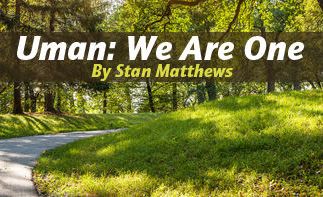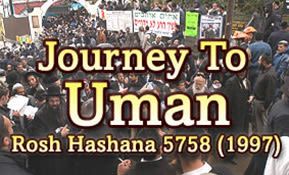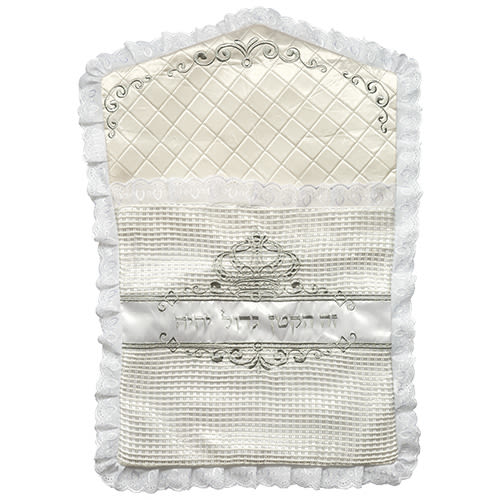
The Kloiz, Part 2
We received letters from Uman that immediately after Rosh Hashanah the Communist newspapers were filled with a series of articles describing the Kloiz as a hotbed of anti-Soviet...

From the Hamber to the Megametor
A Cursory History of the Breslov synagogue in Uman, and its importance to Breslever Chassidim, from Rebbe Natan’s time till today
A Cursory History of the Breslov synagogue in Uman, and its importance to Breslever Chassidim, from Rebbe Natan’s time till today
5594 (1834) — Homecoming
“In 5594 we were worthy of praying in our very own beit midrash. It is impossible to fully recount God’s miracles and wonders in relationship to this. It wouldn’t be believed.” Reb Noson notes further with clear joy that he was able to acquire a beautiful sefer Torah, and everything necessary for a proper beit knesset.
Facelifts
For close to next hundred years the Kloiz was home to the Breslover Chassidim. In 5626 (1866) it was refurbished by Reb Sender of Trehvitza. In approximately 5663 (1903) it was totally renovated by Reb Isaac of Uman. Throughout this entire period the Breslovers warmed themselves by the light of Rebbe Nachman’s teaching. Until 5696 (1936).
5696 (1936) — The Kloiz is Closed
In 5696, after a long period of plotting against the Jews, and after the imposition of unduly heavy taxes levied upon them by the Communist government, the era of the Kloiz came to an end. The late Reb Levy Yitzchok Bender, who was in charge of the Kloiz at the time of its closing, pointed out that the Kloiz was the last beit knesset in the area to be shut down. It had become a repository for all the Torah scrolls of the regional synagogues.
After Reb Levy Yitzchok and the late Reb Elya Chaim Rosen were imprisoned the Kloiz was shut down. This is how the situation was described by Reb Aron Leib Tzigelman:
“We received letters from Uman — from Reb Avraham Sofer, from Reb Matisyahu, from Reb Neshka and from Reb Berel Cohen — that immediately after Rosh Hashanah the Communist newspapers were filled with a series of articles describing the Kloiz as a hotbed of anti-Soviet activity. Those wicked people have gone so far as to actually shut the Kloiz and the mikveh. Darkness covers the faces of our fellow Breslovers. The apple of our eye, our Rebbe’s beit knesset, and the holy mikveh, have been taken away from us. For over 120 years the Rebbe’s fire has burned. What will become of us now?”
50 Years Without the Kloiz
The Evil Empire made the Kloiz its captive and turned it into a factory. Not a factory of Judaism, but just a plain ordinary factory.
* * *
In those dark years the kibbutz was maintained, but only barely so. Few showed up and those that did met secretly, in out of the way houses or in dark cellars. With the Soviet borders sealed tight there were very, very few that made it to Uman. Among them was Reb Michel Dorfman, who succeeded being there dozens of times.
5749 (1989) — Rosh Hashanah at the Hotel Uman
For 50 years “Rosh Hashanah in Uman” was a Breslover fantasy. The might and strength, the atheism and intransigence of Soviet Russia seemed so insurmountable. Nonetheless, Breslover Chassidim kept up a constant stream of prayer, that God would allow the Rebbe’s desire for his chassidim to gather in Uman would yet again become a reality.
Here and there, some chinks in the Soviet armor appeared. Superhuman attempts were made to be in Uman for Rosh Hashanah. In 5749 (1988) a group of about 250 failed to check out of their rooms in the Hotel Uman. They stayed and prayed, and sang and danced. Passersby looked up in confusion at the windows of the old hotel. They could not fathom what was going on. Most were too young to know that there had once upon a time been a synagogue in Uman, and some were too old to remember.
One of those present was the late Reb Shmuel Shapira. He was in his late 70s and suffering Parkinson’s disease. Despite his weakness and pain he persevered so as to be able to fulfill at least once in his life the Rebbe’s advice to be in Uman for Rosh Hashanah. Those who were present can neither describe nor forget the ecstasy expressed in Reb Shmuel’s dance at the close of the holiday.
5750 (1990) — The Kibbutz is Renewed
In 5750 a great miracle occurred — the dream came true. After 50 years the kibbutz was once more! The joy of Breslovers around the world is beyond description. More than a thousand people, including many young children, came from around the world, despite the fact that they had no idea what sort of conditions awaited them. Where they would stay and what they would eat were both matters of conjecture. Yet the longing for “Uman Rosh Hashanah” kept them going.
A large factory was rented and hasty preparations began. The Breslover groundskeepers threw themselves wholeheartedly into their work. The great day would soon be at hand.
The Zaved factory, located in a valley a ten-minute walk from Rebbe Nachman’s grave site, had to be emptied of its machinery, and be cleaned in preparation for Rosh Hashanah. One large hall become the beit knesset, one the dining room and other smaller halls and rooms became dormitories. Some slept in bunk beds in rooms with such low ceilings that those in the upper bunk couldn’t sit up! Many of these rooms had no lighting. Many slept on the floor on mattresses so old that they seemed to have once belonged to the Czar!
No one cared. They were all so thrilled to be worthy of fulfilling a lifelong dream, to be pioneering partners in opening the gates of Uman. And throughout that Rosh Hashanah elderly Jews, who remembered the Uman of long, long ago joined them.
5751-5752 (1991-1992) — The Megametor
With the success of the first year the number of those who came the following year was doubled. The sleeping quarters were vastly improved and the prayers to another factory, the gigantic Megametor. Many of those who came were not Breslovers. They were Jews who simply wanted to be part of Rebbe Nachman’s Rosh Hashanah.
5753 (1993) – The Institute
In 5752 (1992) something unusual happened — The Soviet Union collapsed. One country became sixteen countries without any bloodshed! The foreboding Iron Curtain fell and Ukraine became an independent nation. With the gates wide-open, it became apparent that even the gigantic Megametor would be too small. Something had to be done — and it was.
The Vaad (committee) searched and located an even larger venue. The Institute, a local university, was near completion. It had three large floors, large auditoriums and dormitory facilities. The auditoriums could be — and were — used as a beit knesset and dining room.
That year a new record was achieved. Over 4,000 made it to Uman for Rosh Hashanah! Many crews were formed to assist the newcomers and others who needed help and to prepare the Institute for its guests.
Despite the great success that God granted to the work that was invested, it became obvious from a number of occurrences that Breslov Chassidim would no longer be able to allow themselves to be anyone’s guests. The decision was made: the time had arrived to rebuild the Kloiz! During 5753 (1992-93) a temporary structure was built. There the kibbutz prayed for three Rosh Hashanahs, 5754-5756.
Despite being refurbished for Rosh Hashanah 5756 this structure too was too small. The kibbutz had gone from six minyanim to 600! Over 6,000 people came for Rosh Hashanah! A permanent structure was desperately needed — and soon!
Hashem Runs the World Better than Ever
We ourselves have been privileged to that God does run the world better than before. Breslovers from everywhere are now enjoying the beautiful new home of the “factory of Judaism,” the spacious new home of the kibutz. With the way things are going in Uman, we are quickly outgrowing it too. May we soon see Moshiach the full redemption of our people and the building of the Bet Hamikdash, amen!
***
Rabbi Nasan Maimon is head of the Breslov World Center. Reprinted with kind permission of http://www.breslov.com/












Tell us what you think!
Thank you for your comment!
It will be published after approval by the Editor.